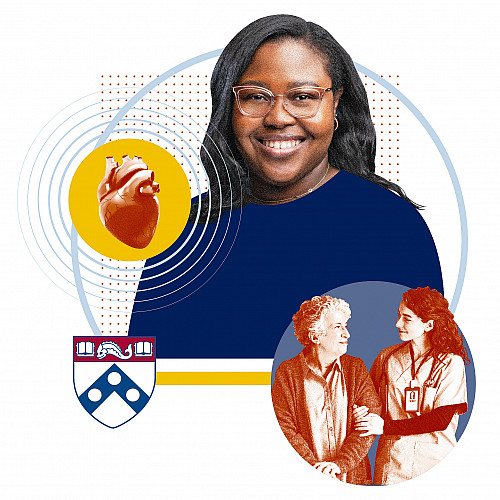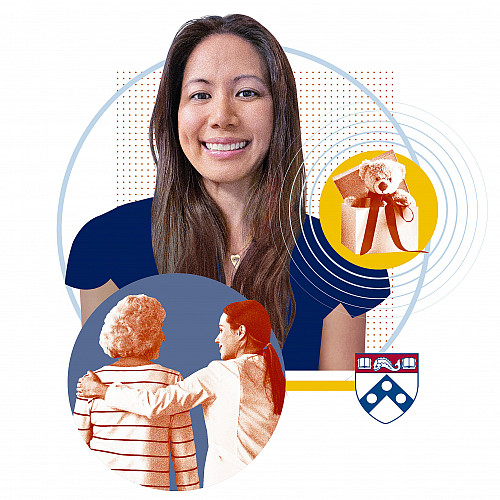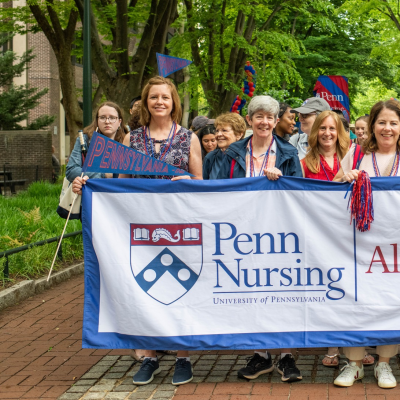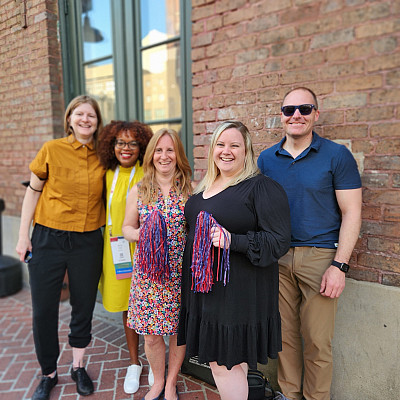The push and pull from the patient bedside to take phone calls. The mounds of plastic trash discarded without any thought about the environment. The readmission rates for patients with heart failure.
Sidebar: A Look Inside Penn Nursing DNP Programs
Penn Nursing offers three unique Doctor of Nursing Practice track options.

These nagging problems haunted Doctor of Nursing Practice (DNP) students throughout the semester at Penn Nursing—and it led to genius solutions that, in many cases, resulted in policy changes in major hospitals.
These solutions—and the work it took to identify the root causes of issues as well as to apply data and expansive stakeholder input to right-size fixes—were presented at Penn Nursing’s first-ever DNP Project Showcase in May.
Penn Nursing Dean Antonia M. Villarruel, PhD, RN, FAAN, GNu’82, says, “When we talk about having an innovation ecosystem at Penn Nursing, these DNP projects are an example of what it empowers. We are developing practice experts who utilize an implementation science approach to ensure quality and safety. These projects and their impact, the result of a whole year of data synthesis and co-creation of solutions and evaluations, is exactly what we envisioned when we launched this program in 2016.”
The goal of each of the projects, the culmination of students’ degrees, is to lead practice scholarship and bring it into practice. Right now, Penn Nursing offers three DNP tracks, two of which are online.
“The online delivery of our Post-Master’s and Executive Leadership DNP courses and program events makes it possible for busy professionals like practicing Nurse Practitioners, managers, public health professionals, and leaders working in the C-suite to successfully complete the program,” says Amy Sawyer, PhD, RN, GR’07, director of the DNP Program. “The online learning experience lends f lexibility to when and where an adult learner completes the work, which is extremely advantageous for professionals balancing myriad responsibilities.”
The online curriculum can be completed in 21 months for the Post-Master’s track and 24-months for the Executive Leadership track. Within each course, learning and instruction emphasizes active engagement among students and with Penn faculty who are field-leading experts.
Sawyer adds, “By creating a virtual classroom in this way, online learners truly feel that they are part of a Penn community while learning together with a national student cohort that bring the richness of diversity to their practice scholarship.”

One Call Away
The phone rang constantly in the 36-bed telemetry unit at Penn Medicine Princeton Health. Nurses were pulled away from bedside care. A patient was having trouble swallowing—one nurse spent 20 minutes trying to contact a doctor and come to a solution, time that took her away from patient care. The frustration was palpable.
“Clinical nurses are feeling so much stress and pressure,” says Karyn Book, DNP, RN, GRN’23, Vice President of Patient Care Services and Chief Nursing Officer at Penn Medicine Princeton Health. “As leaders, we have to prioritize and address inefficiencies in the nurse practice environment.”
Along with colleague Jennifer Hollander, DNP, RN, GRN’23, Director of Patient Care Services, both enrolled in Penn Nursing’s Doctor of Nursing Practice-Executive Leadership program and worked together to find a solution that would allow their colleagues to spend more time with patients without frequent interruption. And just as importantly, avoid the burnout that comes with those interruptions.
Book and Hollander cite the United States Bureau of Labor Statistics projection that employment for registered nurses is projected to grow six percent from 2021 to 2031. About 203,000 openings for registered nurses are projected each year, on average, over that decade. Many of those openings are expected as the result of needing to replace workers who transfer to different occupations or exit the labor force—to retire, for example. Right now, more than 20 percent of nurses indicate their intent to retire from nursing within the next five years.
“As we started to dig deeper into literature it became clear that when looking at job enjoyment, the non-direct care tasks that are taking nurses away from the bedside were found very much to increase the dissatisfaction of nurses,” Hollander says. “They estimated an average of 20 percent of their shift was spent on these non-direct patient care tasks.”
Book and Hollander initiated a four-week intervention with a reduction of non-direct patient care tasks and a nurse dedicated to answering phone calls for nurses from 7am-to-7pm. Their results demonstrated significant positive impact in terms of nurses’ perceptions of the work environment and management support—and led to a significant practice change at Penn Medicine Princeton Health: the placement of a dedicated nurse to manage the call center in the telemetry unit.
“Book and Hollanders’ DNP project is representative of Penn Nursing DNP scholars’ focus on contemporary problems that are critical to address in health care organizations,” says Sawyer. “With a clear understanding of the problem as leaders in their organization, Book and Hollander leveraged the published evidence to identify impactful solutions while simultaneously conducting an organizational assessment using design thinking principles to elucidate unique factors about the target practice setting, interdisciplinary workforce, and human factors (nurses and patients).”
And an equally exciting result of Book and Hollander’s project is their development of a sustainability plan that addresses the potential financial impact for Penn Medicine Princeton Health in reducing nurse burnout to improve nurse retention.
Sawyer notes that Book and Hollander are working within the C-suite to sustain and spread the use of call centers to improve the workplace for nurses and care for patients. She says, “The remarkable practice scholarship demonstrated by Book and Hollander was, in part, informed by scientific work of field-leading scientists at Penn Nursing, including Drs. Eileen Lake, Matthew McHugh, and Linda Pugh, further highlighting our world class science-practice partnership.”

A Reminder Goes A Long Way
The complexity of care required for heart failure patients— even after leaving the hospital—often leads to frequent hospital readmittance. Post-Master’s DNP (PM-DNP) graduate Omolola Olawo, DNP, MScN, RN, GRN’23, a Nurse Manager at UChicago Medicine, says, “I work very closely with our population health team, and a hot topic within the organization has been readmission rates. The population health nurses work on various projects, including a post-discharge line. Given the program was only recently implemented, I thought it would be great to evaluate its effects and provide the team an opportunity to see the bigger picture of their impact.”
At the DNP Project Showcase, Olawo shared her findings: every patient who received a post-discharge call went on to complete a follow-up appointment—but, surprisingly, the data did not show a reduction in 30-day rehospitalizations.
Despite this, Olawo’s study on the impact of transitional care management calls on 30-day readmission rates and observed that such interventions did indeed support the transition from the hospital back into the community setting for the 350 heart failure patients studied at UChicago Medicine. She notes, “I specifically chose patients with heart failure as the target population because we have so many patients affected with cardiovascular related diseases, and—using a health equity lens—it was important to address this.”
Advisor Sue Renz, PhD, DNP, GNP-BC, Nu’84, GNu’87, practice professor and faculty lead, says, “Omolola was disappointed when she looked at results and worried that the project failed. I helped her to think of her outcome differently. There are many reasons patients go back to hospital, and the calls did result in patients scheduling and actually showing up for follow up visits. You have to look at what they did do. These patients could have been lost to follow up and sent back to hospital anyway.”
“My hope is that when they are provided data on the positive effects of their work, there is a much larger connection to what they do.”
Olawo agrees. “To me, this [post-discharge patients who completed follow-up appointments after receiving a post-charge call] was the greatest impact of this project. It demonstrated just how important these calls are in getting patients connected with a health care provider. The real-life application is for the nurses to understand the impact of their work. My hope is that when they are provided data on the positive effects of their work, there is a much larger connection to what they do.”
Transitional care management interventions have health and financial benefits for all stakeholders. Olawo predicts that as care begins to move from hospitals to the community, ambulatory spaces, and homes, there will be more integration with transitional care services.
“Going through the process of a DNP project has given me the opportunity to learn how to apply an evidence-based approach to address practice related issues. I’ve now gained experience in identifying and implementing interventions, and I have been inspired by others to develop innovative solutions to the many complex health care issues we face,” says Olawo.

The Last Memento
We’ve all seen television hospital dramas where dying patients in the ICU have their grieving families gathered around them. But what happens then? After a patient passes, families must often find a way to reconcile their loved ones’ time in the hospital within their bereavement process. Patricia Aligno Bajaj, DNP, RN, CCRN, ACNP-BC, GRN’23, an Acute Care Nurse Practitioner practicing as a Lead Critical Care NP at Penn Princeton Medical Center, envisioned supporting the families of these patients in a more meaningful way—one that could positively contribute to the process of bereavement.
As part of the Post-Master’s DNP Program, Bajaj led interdisciplinary colleagues at Princeton Medical Center to convene and collaborate on a Keepsakes Program. Keepsakes are a form of bereavement support frequently provided with palliative care. Most keepsakes either serve as reminders of the patient’s presence, such as thumbprints and locks of hair, or technology-assisted items like photographs or word clouds.
“In the fast-paced and high-stress ICU environment, we often fail to prioritize the well-being of families and their coping mechanisms,” Bajaj says. “My site lead introduced me to the Three Wishes Project (3WP), a compassionate initiative undertaken by ICUs at UCLA, which grants both keepsake and non-keepsake wishes to families of patients nearing the end-of-life. Although limited data exists regarding the efficacy of this program, the results have been consistently positive, with families welcoming and appreciating this heartfelt gesture.”
It’s the effectiveness of the program that Bajaj wanted to evaluate.
Dr. Thanh Neville, the lead researcher of UCLA’s 3WP project agreed to present the project to stakeholders at Bajaj’s site for the kick-off of her project. Staff at her hospital embraced the idea. Not only did they generously assist with project implementation, they also suggested that providing keepsakes to end-of-life ICU patients and their families should become a standard of care in the ICU.
Bajaj says, “Clinical staff viewed the creation of the keepsake as a gesture of compassion. Given the demanding patient acuity and volume, as well as staffing issues, it was a pleasant surprise that staff nurses were so receptive.”
Despite her initial concern that the keepsake program might be perceived as “morbid or unsettling,” her DNP project revealed keepsakes are highly valued by family members—in fact, many families sought numerous keepsakes.
Bajaj also evaluated time and cost estimates for producing the keepsakes: the price of a keepsake, per family, ranged from $2.63 to $49.01, with an average cost of $12.88 for the staff time required to create a keepsake. A hand mold was the most time consuming, and therefore, more costly.
Price is a minor factor, though, in comparison to the impact keepsakes have on the surviving family. Bajaj says, “One family was so moved by the gesture that they requested information on our hospital’s foundation so they could make a donation in recognition of the keepsakes’ impact.”
Another surviving family expressed their wish that the hospital had offered this service when their other parent passed away a year prior to the project’s implementation.
Bajaj says, “This practice change will continue to enhance end-of-life care even after the project’s completion, thanks to the dedicated bedside nurses at Princeton Medical Center. The staff’s insights regarding how to maximize project implementation success was invaluable.”

What a Waste
Nurses champion health in every way, including environmentally. DNP-Nurse Anesthesia students Catherine Ruggerio BSN BS RN, Dayna Dombrowsky BSN RN, and Rachel Bosco BSN RN were appalled to learn that United States health care facilities produce 6,600 tons of waste daily, and up to 25 percent of that is plastic packaging and plastic products. Of the total waste generated in operating rooms, anesthesia care contributes 25 percent.
Their DNP project proposed an intraoperative recycling initiative at Penn Medicine’s Pennsylvania Hospital. The four-week pilot required some serious dirty work—Ruggierio, Dombrowsky, and Bosco weighed bins and recorded total volume and mass on a weekly basis. They collected a total of 1,369 pounds of waste and 253 pounds of recyclable materials.
Part of the problem, Ruggierio says, stems from a lack of awareness of the sheer volume of trash produced— and how and why intraoperative recycling and equipment is critical for protecting the environment, which in turn can impact patient health.
After stressing the environmental burden to anesthesia providers and operating room staff and providing clearly labeled bins, the volume of waste placed in unsorted trash receptacles decreased by 15.6 percent, an average of 4.57 pounds per week. At the completion of the data gathering period, Ruggierio, Dombrowsky, and Bosco observed a 100 percent increase in recycling weight.
Renz notes that the project was tricky because of limitations that impact what equipment can be placed inside sterile operating rooms. She says, “Team Recycle originally wanted the hospital to consider replacing disposable equipment with reusable equipment that could be sterilized between patients. This was not possible, so they opted to measure trash and recycled materials instead and saw an increase in recycled materials over time.” As it turns out, that was enough to improve knowledge and inspire action among their colleagues.
Now that the project has concluded, Ruggiero says she and her team have measured continued commitment to recycling in all shifts in the particular operating room in which they targeted for their study. She says, “Staff are actively looking for the bins to place recyclable materials. Also, we have found staff still talking about our project months after it has concluded. We feel very proud that we were able to make such an impact on the operating room staff. We really hope our project will lead to sustainable change.”
As a result of their DNP Project, Ruggierio, Dombrowsky, and Bosco are advocating to create a sustainability team or a “green team” at Pennsylvania Hospital to ensure a broader focus on environmental impact when administrators create policies related to waste, emissions, and energy. The academic exercises of the DNP-NA program helped prepare them for implementation by breaking it down into a multitude of sections, focusing on imperative steps, dividing up tasks, and staying on track.
In the ever-changing and complex health care industry, bold leadership and creativity go hand in hand.
To truly revolutionize care delivery models, improve patient and health care worker outcomes, optimize organizational outcomes, and ensure health equity, it requires the right mix of knowledge and skill—and outright grit. Penn Nursing’s DNP program not only prepares graduates for a variety of leadership roles, it prepares them to innovate and recognize the power they have to transform. The DNP Project Showcase highlighted the pipeline of outside-the-box thinking, creativity, excellence in scholarship, and sheer determination for which Penn Nursing is known around the world.
Back to Fall 2023 Issue




